Shoveling is a fundamental skill for many home and garden tasks, from digging holes for a garden bed to clearing snow from driveways. However, there’s a right and wrong way to to dig, and when done incorrectly, it can lead to injury and poor results. Proper shoveling technique combines body mechanics, choosing the right tools for the work, and safety awareness. In this guide, we’ll explore proper shoveling techniques and safety precautions and share tips to make your shoveling tasks easier and more productive. Remember, while shoveling is often a DIY task, there’s no shame in seeking professional help to make large or complex projects more manageable and reduce the risk of injury.
Shoveling Tools
There are various types of shovels and additional equipment that can make your shoveling tasks easier while helping to protect your body. When choosing your tools, think about what material you’ll be digging or moving, how much work you’ll have to do, and whether you’re physically fit enough to handle the work.
Types of Shovels
Different shoveling tasks require different types of shovels. Make sure you choose the right shovel to minimize the strain on your back and joints. Here are some common varieties and their uses:
- Round-point shovel: Ideal for digging and breaking up soil
- Square-point shovel: Best for scooping and moving loose materials
- Snow shovel: Designed with a wide blade for clearing snow
- Trenching shovel: Has a narrow blade for digging precise trenches
- Scoop shovel: Large, curved blade for moving light materials like grain or mulch
Additional Equipment
While you only need a shovel to dig up material, these tools and equipment will help protect you, make the project easier to complete, and let you tackle more complex or intense tasks:
- Wheelbarrow: For transporting heavy loads of soil or debris
- Work gloves: To protect your hands and improve grip
- Safety goggles: To shield your eyes from flying debris
- Knee pads: For comfort during prolonged kneeling tasks with a trowel
- Digging bar: For breaking up hard soil or removing stubborn rocks
- Boots: For protecting your feet and ankles. Make sure that your shoes have good traction to avoid slipping while you work. For reinforced protection, choose steel-toed boots.
Proper Shoveling Techniques
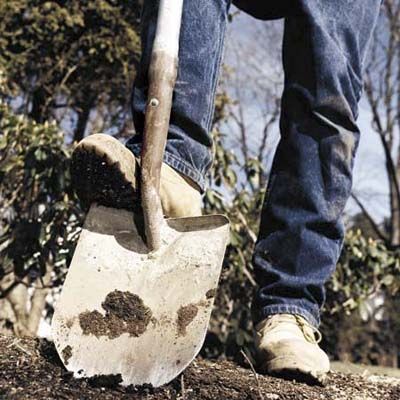
Here, we’ll break down the key shoveling steps—digging in, prying, lifting, tossing, and chopping—and teach you how to complete them properly. Take your time while shoveling to avoid injury, damage to the ground, and to get the best results.
Let’s Dig In
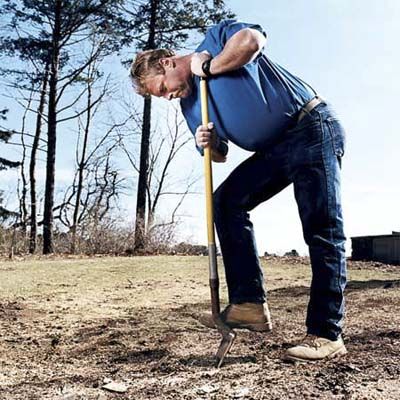
The first step in using a shovel correctly is digging in:
- Position the shovel head (not the handle) perpendicular to the ground, keeping the handle well in front of you and the blade close to your feet.
- Place the center of one foot on the step (the flat part at the top of the shovel blade) and push down.
- Apply concentrated pressure, even a forceful stomp if needed, to sink the blade into the ground.
Digging In Don’ts
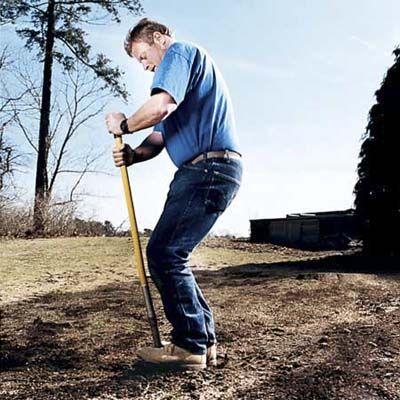
Don’t stomp on the shovel too hard or jump on the head with both feet. If you’re struggling to penetrate the ground, you may need to consider using a pick or another tool to break up the soil first.
Prying the Right Way
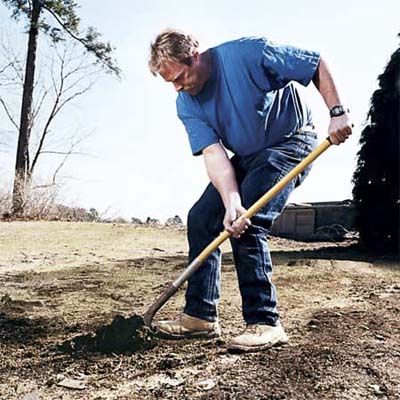
Once you’ve dug into the ground, some prying may be needed to loosen and lift the material. Here’s how to pry away stubborn dirt the right way:
- With the shovel head well planted, keep your back straight and pull your arms toward you.
- Pivot the shovel on the head’s shoulders, using it as a lever.
- If necessary, brace your arm on your thigh for additional support.
Prying Don’ts

Avoid moving your hands too far down the handle, as this can force you to bend at an uncomfortable angle and put strain on your back. Remember that while a shovel can dislodge small stones, it’s not designed as a pry bar. For large or stubborn rocks, use a digging bar or pick instead.
Lift and Toss Away
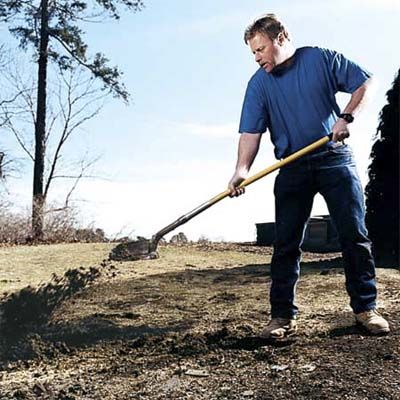
The final step in the shoveling process is lifting and tossing the material. This is where many people risk injury, so proper technique is important:
- Bend at the knees, keeping your back straight.
- Tighten your stomach and core muscles as you lift with your legs to avoid straining your back.
- Use the momentum generated by the upward thrust of your legs to propel the shovel’s contents into a wheelbarrow or onto a tarp.
Lifting and Tossing Don’ts
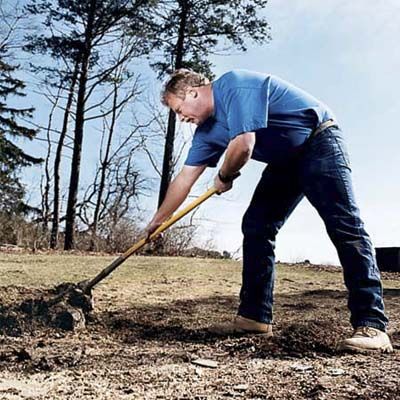
Avoid overextending your arms—keep the load close to your body to make it feel lighter. Also, be careful not to twist your back while shoveling, as this can lead to injury. Be careful not to overload your shovel to avoid putting unnecessary strain on your body.
Chop It Up
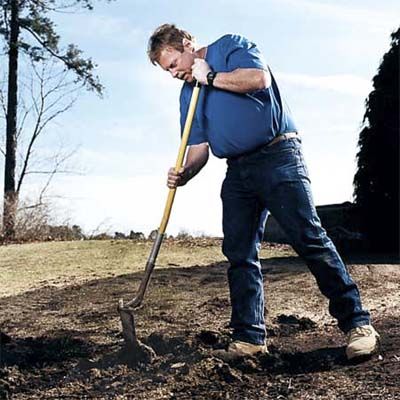
To cut roots or clean up the sides of a hole, flip a long-handled, round-point shovel so the head faces you. This orients the back of the shovel parallel to the sides of the hole, allowing you to chop downward with great force.
Chopping Don’ts
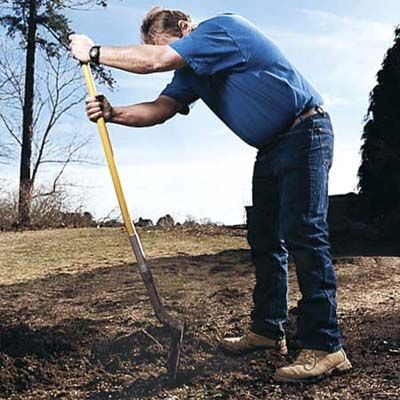
Do not try to chop with the head facing the other way or you’ll have to push the handle too far away to get the head vertical.
Safety Precautions When Shoveling
Safety should always be a top priority when shoveling to prevent injuries and make your shoveling tasks more manageable.
Protect Your Back
Your back is particularly vulnerable during shoveling activities as you’ll be bending and twisting while moving weight. To protect yourself:
- Always bend at the knees, not the waist, when lifting.
- Keep your back straight and use your leg muscles to do the heavy lifting.
- Avoid twisting motions when moving loads—instead, turn your whole body.
- Take frequent breaks to stretch and rest your back muscles.
If you experience persistent back pain while shoveling, stop immediately and consult a healthcare professional.
Avoid Overexertion
Shoveling is physically demanding, and it’s easy to overdo it. Be mindful of your physical limits and take the following precautions:
- Pace yourself and take regular breaks, especially when shoveling snow.
- Stay hydrated by drinking water before, during, and after shoveling.
- Dress appropriately for the weather conditions to avoid overheating or getting too cold.
- Listen to your body—stop immediately if you feel dizzy, short of breath, or experience chest pain. Don’t ignore your body’s signals.
Digging in Different Conditions
Different materials and weather conditions require different shoveling approaches. Let’s look at two common scenarios: shoveling soil and shoveling snow.
Shoveling Soil
When working with soil, whether for building a compost bin or preparing a garden bed, keep these tips in mind:
- Use a round-point shovel for digging and a square-point shovel for moving loose soil.
- Moisten arid soil slightly to make it easier to dig.
- Check for underground utilities such as gas lines before digging deep holes.
- When moving soil, fill the shovel only about two-thirds full to avoid straining yourself.
Shoveling Snow
Snow shoveling requires a different approach:
- Use a plastic snow shovel with a curved blade for easier pushing and lifting.
- Push the snow rather than lift it whenever possible to reduce strain.
- For deep snow, remove it in layers rather than trying to move the full depth at once.
- Spray the shovel blade with cooking spray to prevent snow from sticking.
If you’re over 45 or have health concerns, consult your doctor before doing any heavy snow shoveling.
Shovel Upkeep and Maintenance
Here are some tips to take care of your shovel and keep it in proper working condition:
- Clean your shovel after each use, removing dirt and debris.
- Dry metal parts thoroughly to prevent rust.
- Sharpen the blade periodically with a file to maintain its cutting edge.
- Sand and oil wooden handles to prevent splinters and weathering.
- Store your shovel in a dry place, hanging it if possible to keep the blade off the ground.
DIY vs. Professional Digging Help
While many shoveling tasks can be handled on your own, in some situations, you should seek professional assistance.
Large-Scale Projects
Consider hiring professionals for extensive excavation or landscaping projects. They have the equipment and expertise to move large volumes of material quickly and safely.
Difficult Terrain
If you’re dealing with rocky soil, tree roots, or other challenging conditions, professionals can navigate these obstacles with less risk of injury or property damage.
